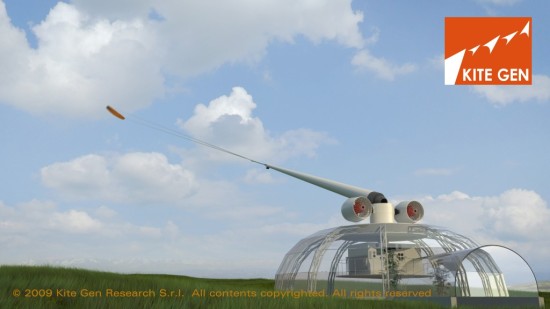
By Ugo Bardi
The kitegen concept: high altitude wind power based on kites. In this configuration ("stem"), the kite reaches altitudes of the order of 1000 m; pulling on a power generator located on the ground. High altitude wind power promises to be a low cost and widely available technology able, in principle, to provide amounts of energy comparable, and even superior, to the present production based on fossil fuels. (See here an animated representation of how a stem works)
…The basic idea of high altitude wind power is that wind is more intense as you move up in the atmosphere. The average wind speed increases with height according to an exponent (called "Hellman exponent") which is about 1/7. But the energy contained in a mass of air in movement increases with the cube of speed. From a simple calculation, we see that if we could raise a wind turbine to a height of 800 m, we could increase the power obtained of a factor of 8 in comparison to the same turbine near the ground. Even larger increases are possible at higher altitudes, where winds are also much more constant; easing the intermittency problem of conventional wind turbines. But of course, it is impossible to reach such heights with the current wind technology, limited to about 100 m because of the cost and weight of the tower.
This concept has been clear for a long time and has led to several proposals to tap the wind at higher heights. There are two possible ways for doing that: balloons and wings. You can find a recent summary of the progress in this area in the work by Big Gav (2009) published on TOD . As you can see, there are many ideas in this field, many of which exist only as sketches on paper. In many cases, the energy yield of the proposed systems is only a guess while, for those systems based on aerostats, the need of a non renewable resource (helium) is a considerable limit.
However, a few systems have been studied in depth and some tested in practical experiments. Systems based on rotors are possible and systems based on kites, in particular, do show a lot of promise. Saul Griffith of Makani Power has shown some images of a test done with a three rope kite. Wubbo Ockels, (Delft University of technology) has been also experimenting with a kite , this one using a single rope. In this field, the most advanced system seems to be the "kitegen"; a kite system created by Massimo Ippolito of Sequoia Automation , a company based in Italy. Tests on a prototype system have been completed and a first energy producing plant is being built in Northern Italy.
The Kitegen is a simple aerodynamic system: it uses state of the art kites which create lift dynamically by flying at 70-80 m/sec; this is the speed reached by the tips of the blades of a conventional wind turbine. In the simplest configuration (called "stem"), the system uses a single kite linked to a power generator located on the ground. The kite moves like a yo-yo: when it goes up, it generates energy that is transformed into electric power by the generator. When it reaches its maximum height, it is placed in an aerodynamically non-lifting configuration, so that it can be pulled down at a very small energy cost. Two coupled stems would work like a two-cylinder engine, although the "power" phase would last 90% of the time while the "pull back" phase would be much faster. A single stem could have a maximum power of a few MW. Larger plants could be operated in the "carousel" configuration. In this case, the kites fly at a constant height and at much higher altitudes, pulling a generator that moves on a circular rail. For a large carousel system, the maximum power obtained can be calculated as of the order of 1 GW or even higher. …
High altitude wind power: an era of abundance?



No comments:
Post a Comment